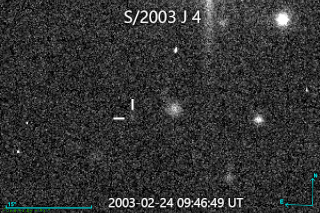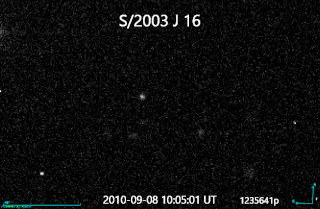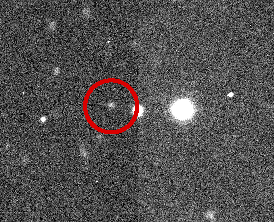
S/2003 J 2 is a retrograde irregular satellite of Jupiter. The moon was discovered on 5 February 2003 by a team of astronomers from the University of Hawaii led by Scott S. Sheppard and David C. Jewitt, and was later announced on 4 March 2003. It was initially thought to be Jupiter's outermost known moon until recovery observations disproved this in 2020.

Eupheme, also Jupiter LX, originally known as S/2003 J 3, is an outer natural satellite of Jupiter, 2 km in diameter.

S/2003 J 4 is a natural satellite of Jupiter. It was discovered by a team of astronomers from the University of Hawaii led by Scott S. Sheppard in 2003.
Eirene, also Jupiter LVII and originally known as S/2003 J 5, is a retrograde irregular satellite of Jupiter. It was discovered by a team of astronomers from the University of Hawaii led by Scott S. Sheppard in 2003 but was then lost. It was recovered in 2017 and given its permanent designation that year.

S/2003 J 9 is a retrograde irregular satellite of Jupiter. It was discovered by a team of astronomers from the University of Hawaii led by Scott S. Sheppard in 2003.

S/2003 J 12 is a natural satellite of Jupiter, and is one of the smallest known natural satellites in the Solar System. It was discovered by a team of astronomers from the University of Hawaii led by Scott S. Sheppard in 2003.
Philophrosyne, also Jupiter LVIII and provisionally known as S/2003 J 15, is a natural satellite of Jupiter. It was discovered by a team of astronomers from the University of Hawaii led by Scott S. Sheppard, et al. in 2003, but then lost. It was recovered in 2017 and given its permanent designation that year.

S/2003 J 16 is a natural satellite of Jupiter. It was discovered by a team of astronomers led by Brett J. Gladman in 2003.

Jupiter LV, provisionally known as S/2003 J 18, is a natural satellite of Jupiter. It was discovered by a team of astronomers led by Brett J. Gladman in 2003.
Jupiter LXI, provisionally known as S/2003 J 19, is a natural satellite of Jupiter. It was discovered by a team of astronomers led by Brett J. Gladman, et al. in 2003.

S/2003 J 23 is a natural satellite of Jupiter. It was discovered by a team of astronomers from the University of Hawaii led by Scott S. Sheppard et al. in 2004 from pictures taken in 2003.
S/2004 S 7 is a natural satellite of Saturn. Its discovery was announced by Scott S. Sheppard, David C. Jewitt, Jan Kleyna, and Brian G. Marsden on 4 May 2005 from observations taken between 12 December 2004 and 8 March 2005.
S/2004 S 12 is a natural satellite of Saturn. Its discovery was announced by Scott S. Sheppard, David C. Jewitt, Jan Kleyna, and Brian G. Marsden on 4 May 2005 from observations taken between 12 December 2004 and 9 March 2005.
S/2004 S 17 is a natural satellite of Saturn. Its discovery was announced by Scott S. Sheppard, David C. Jewitt, Jan Kleyna, and Brian G. Marsden on 4 May 2005 from observations taken between 13 December 2004 and 5 March 2005.
S/2004 S 13 is a natural satellite of Saturn. Its discovery was announced by Scott S. Sheppard, David C. Jewitt, Jan Kleyna, and Brian G. Marsden on 4 May 2005 from observations taken between 12 December 2004 and 9 March 2005.
S/2006 S 1 is a natural satellite of Saturn. Its discovery was announced by Scott S. Sheppard, David C. Jewitt, Jan Kleyna, and Brian G. Marsden on June 26, 2006 from observations taken between January 4 and April 30, 2006. S/2006 S 1 is about 6 kilometres in diameter, and orbits Saturn at an average distance of 18.65 Gm in 951.1 days, at an inclination of 154.6° to the ecliptic, in a retrograde direction and with an eccentricity of 0.0814.
S/2007 S 2 is a natural satellite of Saturn. Its discovery was announced by Scott S. Sheppard, David C. Jewitt, Jan Kleyna, and Brian G. Marsden on May 1, 2007, from observations taken between January 18 and April 19, 2007. S/2007 S 2 is about 5 kilometres in diameter, and orbits Saturn at an average distance of 16,054,500 kilometres in 759.2 days, at an inclination of 176.65° to the ecliptic, in a retrograde direction and with an eccentricity of 0.237. According to Denk et al. (2018), it is presumably at high risk of colliding with Phoebe in the future.
S/2007 S 3 is a natural satellite of Saturn. Its discovery was announced by Scott S. Sheppard, David C. Jewitt, Jan Kleyna, and Brian G. Marsden on 1 May 2007 from observations taken between 18 January and 19 April 2007.
Jupiter LXXII, originally known as S/2011 J 1, is a natural satellite of Jupiter. It was discovered by Scott Sheppard in 2011. It belongs to the Carme group.
Jupiter LVI, provisionally known as S/2011 J 2, is a natural satellite of Jupiter. It was discovered by Scott Sheppard in 2011. Images of the newly discovered moon were captured using the Magellan-Baade telescope at the Las Campanas Observatory in Chile. It is an irregular moon with a retrograde orbit. The discovery of Jupiter LVI brought the Jovian satellite count to 67. It is one of the outer retrograde swarm of objects orbiting Jupiter and belongs to the Pasiphae group.








